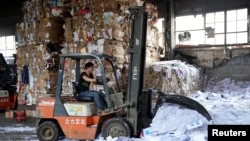ການຕັດສີນໃຈຂອງຈີນທີ່ຈະຢຸດເຊົາຮັບເອົາ “ຂີ້ເຫຍື້ອຂອງຕ່າງປະເທດ” ໄປແປຮູບ ໄດ້ບັງຄັບໃຫ້ ພວກຮັບຂີ້ເຫຍື້ອໄປຫັນປ່ຽນ ແລະເມືອງຕ່າງໆຂອງ ສະຫະລັດ ຕ້ອງ
ໄດ້ຄິດຄືນໃໝ່. ໂມ ຢູ ສົ່ງລາຍງານມາຈາກເມືອງມານາຊັສ ລັດ ເວີຈີເນຍ ດັ່ງ ສາລີ ຈະນຳເອົາລາຍລະອຽດມາສະເໜີທ່ານ ໃນອັນດັບຕໍ່ໄປ.
ຢູ່ໜີ້ ໃນບ່ອນຖິ້ມ ແລະແປຮູບຂີ້ເຫຍື້ອ ໃນເມືອງມານາຊັສ ລັດເວີຈີເນຍ ນີ້ 40 ເປີເຊັນ ຂອງຈຳນວນເຈ້ຍເສດປລາສຕິກແລະວັດຖຸປະເພດອື່ນໆ ແມ່ນ ເຄີຍຖືກສົ່ງໄປຈີນ.
ແຕ່ມາບັດນີ້ ຫລັງຈາກຈີນຢຸດເຊົາບໍ່ຮັບເອົາຂີ້ເຫຍື້ອຈາກປະເທດອື່ນໆອີກ ພວກ ຄົນ
ງານຢູ່ໜີ້ ໃນບໍລິສັດ Republic Service ນີ້ ຈຶ່ງເວົ້າວ່າ ຈະພາກັນສົ່ງໄປ ບ່ອນອື່ນ
ເຊັ່ນອິນໂດເນເຊຍ ແລະຫວຽດນາມ. ນັ້ນໝາຍຄວາມວ່າ ຈະເປັນບັນ ຫາ ຊຶ່ງທ່ານ
Charles Stevenson ເວົ້າວ່າ:
“ບໍ່ແມ່ນວ່າ ທຸກໆປະເທດ ຈະຮັບເອົາໄດ້ຫລາຍຄືກັນກັບຈີນ.”
ນັບວ່າ ເປັນເວລາຫລາຍທົດສະວັດມາແລ້ວ ທີ່ ສະຫະລັດໄດ້ສົ່ງເກືອບວ່າ ນຶ່ງ ສ່ວນ
ສາມຂອງວັດຖຸເພື່ອແປຮູບໄປຍັງປະເທດຈີນ. ໃນປີ 2017 ມັນມີນໍ້າໜັກ ປະມານ
280 ລ້ານໂຕນ ອິງຕາມຕົວເລກຂອງສະຖາບັນອຸດສາຫະກຳແປຮູບ.
ຫາກແຕ່ວ່າ ໃນປີ 2018 ປະເທດຈີນ ໄດ້ມີກົດໝາຍຫ້າມ ບໍ່ໃຫ້ນຳເອົາປລາສ ຕິກ ເອົາເຈ້ຍປະສົມ ແລະວັດຖຸແປຮູບປະເພດອື່ນໆເຂົ້າໄປ. ແລະໃນເດືອນເມ ສາປີນີ້
ປັກກິ່ງ ກໍໄດ້ເນັ້ນຢໍ້າ ເຖິງຄວາມໝາຍໝັ້ນຂອງຕົນ ທີ່ໃຫ້ຫລຸດຜ່ອນນຳ ເຂົ້າ ວັດຖຸ
ເສດເຫລືອທີ່ເປັນຊິ້ນເປັນຕ່ອນ ໃຫ້ລົງເຫລືອສູນ ພາຍໃນປີ 2020.
ທັງນີ້ແມ່ນໄດ້ເຮັດໃຫ້ລາຄາສິນຄ້າປະເພດແປຮູບຫລຸດລົງ ສ້າງບັນຫາຢ່າງໜັກ ໃຫ້
ແກ່ພວກແປຮູບວັດຖຸທັງຫລາຍ ຊຶ່ງທ່ານ Charles Stevenson ປະຈຳ Republic
Service ກ່າວວ່າ:
“ສຳລັບເຈ້ຍປະສົມ ຂ້ອຍຂາດທຶນ 19 ໂດລາ ຂ້ອຍຕ້ອງໄດ້ໃຫ້ຄົນ ຂົນໄປໃຫ້ ຂ້ອຍ.”
ໃນເມື່ອກ່ອນ ມັນເປັນທຸລະກິດທີ່ຫລູຫລາ ເວລາການເຕີບໂຕຂອງເສດຖະກິດ ຂອງ
ຈີນກ້າວໄປຢ່າງວ່ອງໄວ ເວລາມີຄວາມຕ້ອງການສິນຄ້າ ປະເພດນີ້ຢ່າງ ແຮງ.
ແລະການຄ້າຂາຍອັນມະຫາສານ ລະຫວ່າງສະຫະລັດກັບຈີນໄດ້ຊ່ອຍເຫລືອ ພວກ
ແປຮູບວັດຖຸໃນອາເມຣິກາ. ພວກກະຖັງໃຫຍ່ ມາຈາກຈີນ ຈະເຕັມໄປ ດ້ວຍສິນຄ້າ
ຈີນ ເຂົ້າມາໃນຕະຫລາດຂອງສະຫະລັດ ແລ້ວກໍກັບຄືນໄປ ເຕັມ ຍັດໄປດ້ວຍ ວັດຖຸ
ເສດເຫລືອ ເພື່ອນຳໄປແປຮູບ.
ແຕ່ມາບັດນີ້ ຈີນເວົ້າວ່າ ຕົນໄດ້ມີຂໍ້ຫ້າມ ໂດຍອ້າງຕາມຄຳເວົ້າກໍແມ່ນວ່າ “ຂີ້ ເຫຍື້ອ
ຕ່າງປະເທດ” ສ້າງບັນຫາໃຫ້ແກ່ສິ່ງແວດລ້ອມ.
ອາດີນາ ເຣີເນ ແອດເລີ້ ປະຈຳສະຖາບັນແປຮູບວັດຖຸເສດເຫລືອກ່າວວ່າ:
“ນະໂຍບາຍນັ້ນແມ່ນປາກົດວ່າເປັນເລື້ອງສະພາບແວດລ້ອມ ແຕ່ຄວາມຈິງແລ້ວ ມັນ
ແມ່ນກ່ຽວກັບການພັດທະນາທາງດ້ານອຸດສາຫະກຳ. ມັນເປັນຄວາມພະຍາ ຍາມທີ່ຈະ
ບັງຄັບໃຫ້ພວກໝູນວຽນແປຮູບແລະພວກບໍລິໂພກໃນຈີນ ໃຫ້ຊົມໃຊ້ ແຕ່ສິນຄ້າພາຍ
ໃນເທົ່ານັ້ນເອງ.”
ປະເທດຈີນຍັງສືບຕໍ່ຮັບເອົາຈຳພວກເສດເຫລືອທີ່ເປັນຊິ້ນເປັນຕ່ອນບາງແນວຢູ່ ເຊັ່ນ
ເຈ້ຍ
ກະດາດແຂງເປັນຕົ້ນ. ແຕ່ກໍໄດ້ຈັດຕັ້ງຂອບເຂດຈຳກັດໄວ້ ບໍ່ໃຫ້ກາຍ 0.5% ຊຶ່ງພວກ
ອຸດສາຫະກຳເວົ້າວ່າເຮັດບໍ່ໄດ້.
ພວກນັກວິເຄາະທັງຫຼາຍເວົ້າວ່າ ປັດຈຸບັນ ສະຫະລັດກຳລັງຄິດພິຈາລະນາ ທວນຄືນ
ເບິ່ງຢູ່. ທ່ານນາງ ແອນ ເຈິມັນ ປະຈຳສະມາຄົມວັດຖຸເສດເຫລືອ ແລະແປຮູບແຫ່ງຊາດ
ເວົ້າວ່າ:
“ນັບເປັນເວລາຫລາຍປີມາແລ້ວຢູ່ໃນສະຫະລັດ ທີ່ຈຸດເພັ່ງເລັງ ແມ່ນສຸມໃສ່ ສົ່ງເສີມໃຫ້
ຄົນໝູນວຽນວັດຖຸ ໃຫ້ປະກອບສ່ວນແທ້ໆວ່າໆ ໃນການໝູນວຽນ ວັດຖຸ ໂດຍບໍ່ໄດ້ເນັ້ນ
ໜັກໃສ່ການທຳຄວາມສະອາດຂອງວັດຖຸແລະມາບັດນີ້ ຈຸດສຸມແມ່ນ ໄດ້ປ່ຽນແປງໄປແດ່
ເລັກນ້ອຍ.”
ອຸດສາຫະກຳດັ່ງກ່າວ ດຽວນີ້ ແມ່ນແນໃສ່ການຜະລິດວັດຖຸເສດເຫລືອ ໃຫ້ສະ ອາດ
ແລະສົ່ງເສີມການແປຮູບສີຂຽວ ຊຶ່ງທ່ານນາງເຣີເນ ແອດເລີ້ ກ່າວວ່າ:
“ບັດນີ້ພວກເຮົາມີການລົງທຶນຢ່າງໃຫຍ່ ຢູ່ອຸດສາຫະກຳ ເພາະສະນັ້ນ ພວກເຮົາ ຈຶ່ງ
ມອງເຫັນວ່າ ການດຳເນີນ ພວມມີໄປຢູ່ ໃນສະຖານທີ່ແຫ່ງນິ້.”
ມັນຈະກິນເວລາໄປອີກຫລາຍປີ ກ່ອນມັນຈະກຸ້ມຄ່າ ແຕ່ບຸກຄົນເຊັ່ນແອດເລີ້ ແມ່ນ
ເຊື່ອວ່າ ອຸດສາຫະກຳດັ່ງກ່າວ ຈະທຳການແປຮູບວັດຖຸໄປຫລາຍຂຶ້ນຕື່ມ ໃນອະນາ
ຄົດຂ້າງໜ້າ.”
ເຊີນເບິ່ງວີດີໂອພາສາອັງກິດຕື່ມກ່ຽວກັບຂ່າວນີ້
China's decision to stop accepting "foreign garbage" for recycling has forced U.S recyclers and cities to rethink recycling.Mo Yu reports from Manassas, Virginia.
At this waste and recycling facility in Manassas Virginia, 40 percent of its paper, plastics and other materials used to go to China.
But now that China has stopped taking waste from other countries, staff here at Republic Services say they'll be sending it to paces like Indonesia and Vietnam.That presents a problem.
"Not every country can take as much as China used to."
For decades, the U.S. sent about a third of its recycled materials to China.In 2017, that was about 280 million tons, according to industry figures.
But in 2018, China enacted an import ban on plastics, mixed paper and other recyclable materials.An in April, Beijing reaffirmed its comitment to reduce solid waste imports to zero by 2020.
That's driving down the price of recyclables, hurting U.S. recyclers.
"On mixed paper I'm negative 19 dollars, I'm paying people to take it for me."
It was a lucrative business in the past, when China's rapid economic growth spurred a demand for scrap.
And robust U.S.-China trade helped recyclers in America. Containers that arrived from China filled with goods for U.S. markets returned to China filled with recyclables.
But China's says it imposed the ban because all that-quote - "foreign garbage"caused environmental problems.
"The policy was ostensibly about the environment, but in reality it's about industrial development. It's an effort to force recyclers and consumers within China to only supply from domestic sources."
China still accepts shipments of certain types of solid waste like cardboard. But it set the contamination threshold at 0.5%, which the industry says can't be met.
Analysts says the U.S. is rethinking recycling.
"For years in the United States, the focus has been on encouraging recycling, trying to get greater participation in recycling, without such a strong emphasis on cleaning up the recycling, and now the focus kind of shifted a little bit."
The industry is focusing more on producing cleaner waste and promoting greener recycling.
"We have a whole lot of investment taking place in the industry now, so we are seeing a lot of that processing take place here."
It'll take years for that investment to pay off, but people like Adler believe the industry will recycle even more in the future.
From grubby packaging engulfing small Southeast Asian communities to waste piling up in plants from the US to Australia, China's ban on accepting the world's used plastic has plunged global recycling into turmoil.
For many years, China received the bulk of scrap plastic from around the world, processing much of it into a higher quality material that could be used by manufacturers.
But at the start of 2018, it closed its doors to almost all foreign plastic waste, as well as many other recyclables, in a push to protect the local environment and air quality, leaving developed nations struggling to find places to send their waste.
"It was like an earthquake," Arnaud Brunet, director general of Brussels-based industry group The Bureau of International Recycling, told AFP.
"China was the biggest market for recyclables. It created a major shock in the global market."
Instead, plastic is being redirected in huge quantities to Southeast Asia, where Chinese recyclers have shifted en masse.
With a large Chinese-speaking minority, Malaysia was a top choice for Chinese recyclers looking to relocate, and official data showed plastic imports tripled from 2016 levels to 870,000 tonnes last year.
In the small town of Jenjarom, not far from Kuala Lumpur, plastic processing plants suddenly appeared in large numbers, pumping out noxious fumes day and night.
Huge mounds of plastic waste, dumped in the open, piled up as recyclers struggled to cope with the influx of packaging from everyday goods, such as foods and laundry detergents, from as far afield as Germany, the United States, and Brazil.
Residents soon noticed the acrid stench over the town -- the kind of odor that is usual in processing plastic, but environmental campaigners believe some of the fumes also come from the incineration of plastic waste that was too low quality to recycle.
"People were attacked by toxic fumes, waking them up at night. Many were coughing a lot," local resident, Pua Lay Peng, told AFP.
"I could not sleep, I could not rest, I always felt fatigued," the 47-year-old added.
Toxic fumes
Pua and other community members began investigating and by mid-2018 had located about 40 suspected processing plants, many of which appeared to be operating secretly and without proper permits.
Initial complaints to authorities went nowhere but they kept up pressure, and eventually the government took action. Authorities started closing down illegal factories in Jenjarom, and announced a nationwide temporary freeze on plastic import permits.
Thirty-three factories were closed down, although activists believe many have quietly moved elsewhere in the country. Residents say air quality has improved but some plastic dumps remain.
In Australia, Europe and the US, many of those collecting plastic and other recyclables were left scrambling to find new places to send it.
They face higher costs to get it processed by recyclers at home and in some cases have resorted to sending it to landfill sites as the scrap has piled up too quickly.
"Twelve months on, we are still feeling the effects but we have not moved to the solutions yet," said Garth Lamb, president of industry body Waste Management and Resource Recovery Association of Australia.
Some have been quicker to adapt to the new environment, such as some local authority-run centers that collect recyclables in Adelaide, southern Australia.
The centers used to send nearly everything -- ranging from plastic to paper and glass -- to China but now 80 percent is processed by local companies, with most of the rest shipped to India.
"We moved quickly and looked to domestic markets," Adam Faulkner, chief executive of the Northern Adelaide Waste Management Authority, told AFP.
"We've found that by supporting local manufacturers, we've been able to get back to pre-China ban prices," he added.
Consume less, produce less
In mainland China, imports of plastic waste have dropped from 600,000 tonnes per month in 2016 to about 30,000 a month in 2018, according to data cited by a new report from Greenpeace and environmental NGO Global Alliance for Incinerator Alternatives.
Once bustling centers of recycling have been abandoned as firms shifted to Southeast Asia.
On a visit to the southern town of Xingtan last year, Chen Liwen, founder of environmental NGO China Zero Waste Alliance, found the once-booming recycling industry had disappeared.
"The plastic recyclers were gone -- there were 'for rent' signs plastered on factory doors and even recruitment signs calling for experienced recyclers to move to Vietnam," she told AFP.
Southeast Asian nations affected early by the China ban -- as well as Malaysia, Thailand and Vietnam were hit hard -- have taken steps to limit plastic imports, but the waste has simply been redirected to other countries without restrictions, such as Indonesia and Turkey, according to the Greenpeace report.
With only an estimated nine percent of plastics ever produced recycled, campaigners say the only long-term solution to the plastic waste crisis is for companies to make less and consumers to use less.
Greenpeace campaigner Kate Lin said: "The only solution to plastic pollution is producing less plastic."










